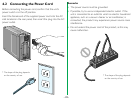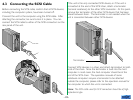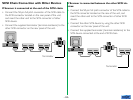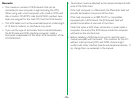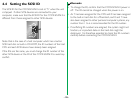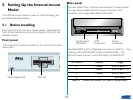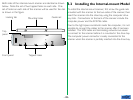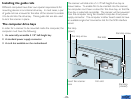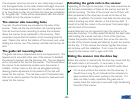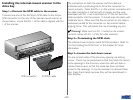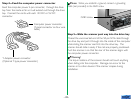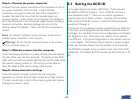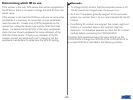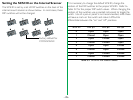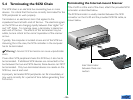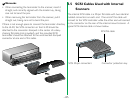
- 30 -
The computer drive bay has one or two metal stops screwed
into the tapped holes on the sides of each half-height drive slot.
These should be loosened to allow them to either be removed
or to hang freely so they do not block the drive bay receptacles
for the guide rails. These will be repositioned after the scanner
is installed to lock the scanner in place.
The scanner side mounting holes
Two sets of vertical holes are provided on the sides of the
scanner. These are the top and bottom rail mounting holes.
One set must be chosen according to where the computer
allows the scanner to be positioned in the drive bay. Most
computers require that the bottom set of mounting holes be
used. Position the rails at the bottom of the scanner and, while
holding the scanner, see if the scanner will slide into the bay rail
slots.
The guide rail mounting holes
The guide rails have a tapered end and a non-tapered end. The
tapered end is mounted at the rear of the scanner to facilitate
the scanner’s insertion into the drive bay slot. The non-tapered
end is mounted at the front of the scanner. This flat end allows
the scanner to be locked into position once the scanner is
installed. Certain holes on the rails are elongated vertically,
allowing precise adjustment of the position of the rails with
respect to the scanner. The rails have a set of horizontal holes
that can be used to position the rails forward or backward with
respect to the scanner.
Attaching the guide rails to the scanner
Depending on the type of computer, it may take several tries to
find the best combination of holes on the scanner and rails for
optimal mounting. The face of the scanner has to fit flush with
other peripherals in the drive bays as well as the face of the
computer. In addition, the scanner must slide into the drive bay
without touching any other devices, or the drive bay itself. It
should sit so that the cutout in the computer front panel aligns
with the front of the scanner.
Several attempts may be required to align the scanner in the
computer drive bay. It is often easiest to identify the best holes
while holding the scanner and rails in front of the drive bay.
Choose the position that looks best, then screw the rails into
the side of the scanner loosely and attempt to push the scanner
into the bay. If it fits, remove the scanner, tighten the screws
and continue with the installation. If not, move the rails with
respect to the scanner and try again until it fits.
Sliding the scanner into the drive bay
Before the scanner is inserted into the drive bay, insure that the
DIP switch block is set correctly. In rare cases, it may be
necessary to change the configuration of the DIP switch block.
On no account force the scanner into the drive bay. It
should have a snug fit, yet it should not be necessary to
apply excessive force when pushing in the scanner. If it
does not slide in easily, reposition the guide rails or
visually check the drive bay to see what might be blocking
the path of the scanner.



